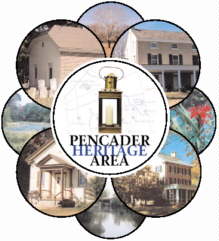 The village of Glasgow is located in the center of Pencader Hundred, which also places it in the center of Welsh Tract. Prior to being
called Glasgow it was called New Glasgow, Aikentown, Aiken's Tavern and Pencader. It was formed around Pencader Meetinghouse built shortly after William Penn set up the 30,000 acre land grant known as Welsh Tract in 1701. How or why the name Glasgow was chosen is not certain. It may have been named after Glasgow, Scotland or for a local landowner William Glasgow. During the Revolutionary War the name Aiken's Tavern was used, deriving from the tavern operated by John Aiken.
The village of Glasgow is located in the center of Pencader Hundred, which also places it in the center of Welsh Tract. Prior to being
called Glasgow it was called New Glasgow, Aikentown, Aiken's Tavern and Pencader. It was formed around Pencader Meetinghouse built shortly after William Penn set up the 30,000 acre land grant known as Welsh Tract in 1701. How or why the name Glasgow was chosen is not certain. It may have been named after Glasgow, Scotland or for a local landowner William Glasgow. During the Revolutionary War the name Aiken's Tavern was used, deriving from the tavern operated by John Aiken.
In 1791 Matthew Aiken, brother of John, purchased land from James Stewart that adjoined the Meetinghouse now known as Pencader Presbyterian Church. It was Aikens intention to lay out a planned single street village. Other towns or villages in the region, such as Newark, Christiana, and Stanton grew as unplanned communities. When Matthew Aiken purchased the land consisting
of about nine acres, only a few buildings besides the church were present: 'a large and commodious Brick House, Brick Store House and lot of Ground with other improvements, known by the name of Aiken's Tavern', a 'lot of Ground with a Two-Story Brick Messuage; Tan Yard and other improvements' located to the south of the in tersection, a blacksmith shop, a frame house, and three log dwellings. The north-south road at Glasgow ran North to Cooch's Bridge and South to Middletown. The road West to Elkton started from Aiken's Tavern (about 1200 feet of the present intersection). The road East to New Castle started just south of the Tavern and angled off behind the Pencader Church. The remains of this road can still be seen on the church property. The present day intersection was laid out as a result of a petition in 1799 making the crossroad approximately that of the current southbound lane of Route 40.
The village grew rapidly and the 1800 U.S. Census reported 25 dwellings and 159 inhabitants. Despite the fact that the New Castle and Frenchtown Turnpike (chartered 1809 completed 1816) went through Glasgow the growth of the village nearly slowed to a halt and the 1810 Census showed only 29 separate households and a total population, including free blacks and slaves, of 177. Maps from the late 1800's reveal little growth with houses mainly on the north-south roadway. Also the maps show a strange feature in the east-west road called the devil's elbow. The road passes west through Glasgow then makes a right angle turn to the south for a
short distance then right again to the west. The turn in the road is on the north and west of the historic building known as the
Mechanic's Row in the early 1800's. A Post Office was opened in Glasgow on January 3, 1828 under Jacob Whiteman. Robert T.
Cann was postmaster in 1841, George Boulden in 1888, and Zachary Taylor Harris was postmaster on December 31, 1912, when
the office was closed. Other postmasters were William Alrichs, Miss Margaret Adair, and Samuel Alrichs.
|
